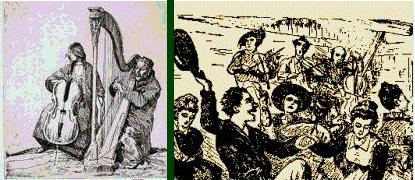"One of the things that I forgot to mention in terms of technique is my sources for 18th Century technique. The Scottish Fiddle School that we work with (Jink & Diddle, after a Robert Burns poem) emphasizes Scottish 18th Century, including a few things that are probably counter to modern practice.
"Open strings are not bad. There are many times when you want to play a note with an open string and not the same note higher up on a lower string.
"Vibrato is an ornament, to be used as an ornament and not on every note that is long enough to vibrato. As I recall, the modern heavy use of vibrato did not really come into vogue until the early 20th century.
"Music is frequently not played quite the way it is written.
"A lot of the repertoire is dance music, or began as dance music, and has a pulse - emphasis and the first beat of each bar.
"Another one that I have liked is Francesco Geminiani's "Art of Playing the Violin". Geminiani was a student of Corelli who moved to England, and I tend to think of him as, like Handel, English, though he was not born in England. His 1751 book was published in English and was one of the foremost technique books of its time. Early in the book he says that it may have some value as well to those who play the cello. IF you can find a reprint in a library, take a look at what he says about playing, and about ornaments. He lists and discusses the 14 Ornaments, one of which is holding the pure note - not shakes, no trill, no vibrato (close shake).
Geminiani’s 14 Ornaments
1 Plain Shake Trillo semplice
2 Turned Shake Trillo composto
3 Superior Appogiatura
4 Inferior Appogiatura
5 Holding a Note “It is necessary to use this often, for were we to make Beats and Shakes continually without sometimes suffering the pure note to be heard, the Melody would be too much diversified.”
6 Staccato “Rest, taking Breath, or changing a Word…..where it may not interrupt the sense.”
7 & 8 Swelling and Softening the Sound
9 & 10 Piano and Forte – “..to produce the same Effects that an Orator does by raising and falling his Voice.”
11 Anticipation
12 Separation – designed to give a variety to the Melody…it will not be amiss to add a beat, and to swell the note, and then make the Appogiature to the following note…
13 Beat
14 Close Shake – Tremolo, or perhaps what we would call extreme vibrato
Then there are some nice quotes from others:
Music is invaluable where a person has an ear. It furnishes a delightful recreation for the hours of respite from the cares of the day, and lasts us throughout life. – Thomas Jefferson, 1818
Every melodic piece contains one phrase at least from which the variety of tempo of the music can be clearly recognized. This phrase…often compels one into its own natural speed. Leopold Mozart, 1756
…certain deliberate disturbances of the beat are extremely beautiful…certain notes and rests should be prolonged beyond their written length for reasons of expression (1753) The attempt should be made to hold the tempo of a piece just as it was at the start, which is a very difficult achievement. (1787) C.P.E. Bach

1 comment:
Hi Terry,
I enjoyed the information from Maynard Johnson. Have you incorporated ornamentations into your playing? I assume ornamentations are appropriate for both solo and accompaniment playing.
Marilyn
Post a Comment